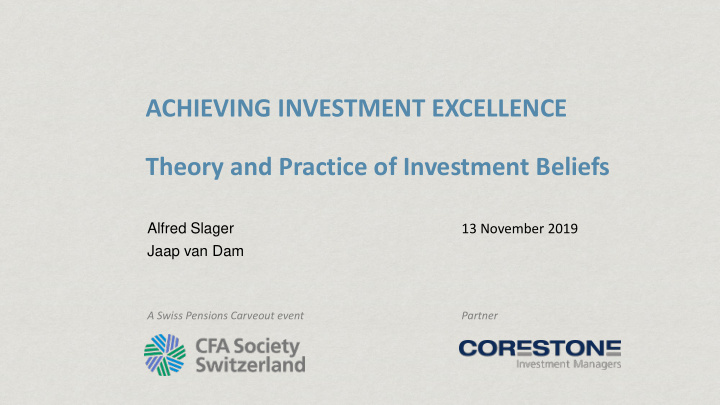



ACHIEVING INVESTMENT EXCELLENCE Theory and Practice of Investment Beliefs Alfred Slager 13 November 2019 Jaap van Dam A Swiss Pensions Carveout event Partner
1. The board as a source of return 2. Investment beliefs – why it matters and works 3. Working with beliefs: the case of a large Dutch pension fund 2
1. The board as a source of return The sources of prolonged below average performance of pension funds are basically a lack of board governance budget: • knowledge, skills, behavior So boards are key in the long term success or failure: they make the decisions. Large research project to help trustees worldwide, ending in this book. 3
How to position beliefs? How do we achieve with our investments what we want to achieve? They help you to enhance effectiveness. Provides guidance to key decisions: - Designing the process - Implementing the Investments - Deciding and Adapting 4
2. Investment beliefs – why it matters and works 5
My lessons All investment choices have assumptions. These assumptions are tested at the worst possible times. Good boards think through them beforehand . And the way to do this is by formulating your beliefs . 6
Key questions What are investment beliefs – why do we need them? How do we link them to implementation? When do we change them? What mistakes should we avoid? 7
How it works 8
Starter set: 80% of the decisions Belief 1: Strategic Asset Allocation is the most important choice in the investment process. Belief 2: Active management does not pay off. Belief 3: Costs determine net return. Belief 4: There are only a select number of risk premiums worth pursuing. Belief 5: Simplicity pays off: we match governance and strategies. Belief 6: We only invest if we agree on when to exit. Belief 7: Sustainability is an opportunity, not a necessity. Belief 8: Checking against procyclical behavior pays. 9
Linking beliefs to implementation Value added for implementation Focus board 10
When to change them? Not when results disappoint, but when evidence changes 11
Mistakes to avoid Beliefs that are copied from industry leaders. Beliefs based on results Too simplified beliefs “I strongly believe in . . . ”: hope kicks in 12
3. Working with beliefs: the case of Dutch pension fund PFZW
The Challenge 2011… 1. Need for strategic redirection after the Great Financial Crisis 2. Many new people on the board and new roles 3. Lack of clarity on shared principles guiding investment decision making 4. Need for disciplined & collective guidance to the fiduciary manager (PGGM) 14
Process 1. Strong commitment of 6 key board members 2. Outside in views – many experts interviewed 3. Board takes the lead. Serious amount of board time committed 4. Collectively embraced by board 15
Framework The principles laid down in the “investment framework” provide the basis for the strategic plans (2015 – 2020 and now 2020 – 2025). Three dimensions: • How to achieve financial goals • How to look at responsibility • How to be in control Every investment decision is guided by the same 5 criteria: • Contribution to financial goals • Contribution to sustainable / responsible investing • Cost • Controllability / complexity • Communication / explainable 16
Outcomes • Increased board comfort on the oversight of the investments – focus on forest • Decision making on the basis of standardized documents • Complexity of portfolio was reduced – e.g: exit hedge funds • Investment cost has been significantly lowered, efficient implementation • Discipline in how we think we can generate returns, e.g., not TAA, not active in public markets, etc. • Basis for next steps in responsible investing 17
Ownership, maintenance, and review of investment beliefs 1. The beliefs have to be alive and kicking. This is not always easy 2. Ownership of the beliefs is in the hand of the board… 3. …but board members come and go 4. Critical moments: do new members subscribe to the beliefs? Do you formally educate them? 5. Reviewing and maintenance are key. In the end, the beliefs are a set of working hypotheses that can and should be improved. 18
Practical Advice When to consider building (new) investment beliefs? 1. Leakage / Sub-optimal outcomes (cost, negative alpha) 2. Board / Investment Committee not does not feel in control the investment process / manager 3. Waste of board time on decision making, focus on trees, not on the forest 4. When you seriously want to move up the excellence ladder As a smart investor, you have a huge interest in having a great board. It will improve the value chain and lengthen and deepen relations between boards and investors. 19
Summarizing our key take aways Investment beliefs invaluable tool to be a successful long-term investor. Good beliefs are owned by the board, shared and used daily Trustees to take ownership of the investment process When to change your beliefs? Do not try this at home: what to avoid 20
ACHIEVING INVESTMENT EXCELLENCE Theory and Practice of Investment Beliefs Alfred Slager 13 November 2019 Jaap van Dam A Swiss Pensions Carveout event Partner
Contact us at www.achievinginvestmentexcellence.com or Alfred Slager: TIAS Business School, a.slager@tias.edu Jaap van Dam: www.vandaminvestmentadvisory.com 22
Recommend
More recommend